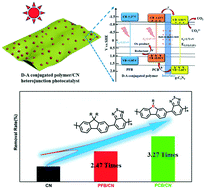Heteroatom engineering of polymeric carbon nitride heterojunctions for boosting photocatalytic reduction of hexavalent uranium†
Abstract
Herein, for the first time, the authors report metal-free heterojunction photocatalysts consisting of push–pull conjugated polymers and polymeric carbon nitride (CN) for efficient reduction of uranium. Furthermore, the authors innovatively proposed a heteroatomic engineering strategy to further improve the visible-light capture ability and separation of electron–hole pairs of heterojunction photocatalysts via replacing carbon atoms in donors by nitrogen atoms. The result revealed that in the photocatalytic reduction of uranium, the kinetic constant of PFB/CN (0.037 min−1) was 2.47 times higher than that of CN (0.015 min−1). Notably, copolymerization of a nitrogen-containing electron donor carbazole unit into the polymer backbone would further widen the light response range and promote electron–hole separation within PCB/CN as compared to PFB/CN, leading to a higher kinetic constant (0.049 min−1), 3.27 times higher than that of CN. The current work underlines that adapting a reasonable heteroatomic engineering strategy for polymer heterojunctions is a remarkably effective strategy to develop up-and-coming organic semiconductor photocatalysts for efficient reduction of uranium.



 Please wait while we load your content...
Please wait while we load your content...